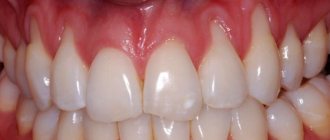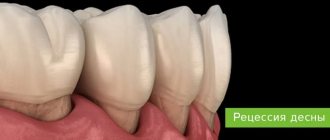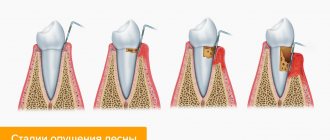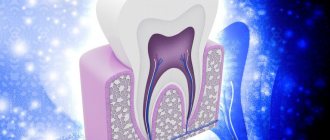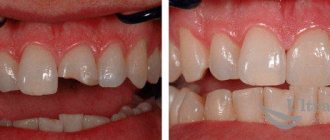Symptoms of pulpitis
- monotonous and aching pain at the initial stage of the disease,
- very strong and acute pain, which worsens closer to night. Unlike ordinary caries, the pain does not decrease, even if the irritant is removed, i.e. stop eating, drinking or brushing your teeth,
- reaction to temperature stimuli - hot and cold, and quite strong and pronounced,
- pain and acute reaction when tapping on the tooth.
Pulpitis is quite difficult to confuse with other diseases precisely because of the specific pain that accompanies the acute course of the disease. As a rule, black carious spots are present on the tooth at the same time, including they can be located under the filling (in this case it becomes dark), as well as under the crown (if the nerve has not been removed, however, in such a situation, carious inflammation will not be visible) .
Removal with arsenic
Once upon a time there was only one way to remove it, it was terribly painful, especially since you had to visit the doctor several times. At first, the doctor drilled the tooth down to the pulp with a drill, which was extremely painful. Next, arsenic was placed in the hole and it was temporarily sealed with a filling. In a couple of days, the arsenic dealt with the nerve, and the tooth hurt so much that no medicine could help. Then I had to go to the doctor again, he opened the temporary filling, removed the nerve, and cleaned the root canals. Pulp is a tenacious substance, so this process was also extremely painful.
This technology poses a certain danger, because arsenic is a poison, and the doctor, when using it, must be especially careful, and the patient must be careful: if you are late with the second visit to the doctor and leave arsenic in the tooth, it will completely destroy it, which will end deletion. Dentists stopped using arsenic and developed new techniques for removing pulp.
Reasons for the development of the disease
- untreated caries or poor quality of filling, when an inflammatory process has developed again under the installed filling,
- preservation of the nerve under the crown - in this case (if the tightness of the prosthesis is broken, there is inflammation underneath) there is a high risk of pulp inflammation,
- tooth injury – inflammation penetrates from the outside, i.e. through cracks and chips that are located on the root or in close proximity to it,
- exposure to aggressive stimuli - temperature and chemical, for example, during previous canal treatment, naturally, with an incorrectly selected dosage of the drug.
Causes of inflammation of the dental nerve
Infection in the pulp.
Most often this happens as a result of complications of untreated caries. The carious cavity expands, bacteria penetrate into the pulp and infect it. The infection can also enter the pulp through the apex of the tooth root from deep periodontal pockets with gum disease or through blood from other foci of infection.
Tooth trauma with damage to the pulp chamber, bruxism.
Even a small crack in the tooth enamel can allow bacteria from the oral cavity to penetrate into the pulp and cause inflammation. Therefore, any, even minor, tooth injury requires consultation with a dentist and subsequent observation if there is a suspicion of opening of the pulp chamber. If there is an open pulp, the tooth requires urgent endodontic treatment.
Doctor's mistakes.
Incorrect actions by the dentist can also damage the pulp and provoke inflammation. This may happen if:
- the tooth was treated with too aggressive alcohol or alkaline solutions during treatment,
- the pulp was overheated during the preparation of tooth tissue without sufficient cooling,
- the pulp chamber was damaged due to negligence during the treatment of caries,
- a filling material was used that caused an allergic reaction in the patient.
Complications of pulpitis
If you do not consult a dentist in a timely manner, pulpitis can develop into a more serious disease - periodontitis, cyst or granuloma, periostitis. That is, the inflammation will go deeper and go beyond the tooth root. Such complications can lead to tooth extraction, after which neighboring teeth will begin to shift, leading to malocclusion. Since the disease causes some discomfort while chewing food, the patient may face serious gastrointestinal problems.
Features of the treatment of trigeminal neuralgia
Toothache with neuralgia is a signal to immediately seek help from a neurologist. Inflammation of the trigeminal nerve is a serious problem that requires qualified assistance. Treatment of neuralgia must be comprehensive to achieve the best results in the fight against the disease.
In the process of treating neuralgia, it is important to correctly determine the cause and type of inflammation in order to be able to prescribe the appropriate treatment. When secondary neuralgia develops, before treating the main problem, it is necessary to eliminate the disease that was the cause.
To eliminate trigeminal neuralgia, specialists use therapeutic and surgical treatment methods. Most often, drug treatment is used in the form of drugs with an anticonvulsant effect, antihistamines, and vitamin therapy. However, if the use of medications is ineffective, it becomes necessary to act on the nerve through surgery.
Treatment methods
Treatment of pulpitis is carried out in a complex: as a rule, the nerve is removed (only in rare cases, when there is slight inflammation, it can be treated with medication and thereby kept alive for some time). After this, the canals are filled and the coronal part is restored if it is destroyed. Diagnosis and treatment monitoring are necessarily carried out using an x-ray - a targeted image of one tooth.
Dental canal treatment The dental canals are cleaned using special instruments and medications. The treatment takes 2 visits - during the first, the nerve is removed and the cavity is thoroughly cleaned. In the second, the quality of the treatment is assessed, the temporary filling is removed and a permanent one is placed.
Price:
from 4,500 rubles more details about the solution
Installation of a core tab After cleaning the dental canals, if the crown is almost completely destroyed, i.e. under the root, it is necessary to restore the tooth. An inexpensive option is to install a pin, but a more rational option is to make a stump tab that completely replicates the structure of the root system. This way the load is distributed more evenly, so the tooth will last longer. Next, you can install a crown or line the top of the inlay with a composite material.
Price:
from 5,000 rubles more details about the solution
Installing a crown Installing a crown after treatment of pulpitis may be necessary if the apex of the tooth is destroyed by more than half. For the lateral teeth, the best option would be to use metal-ceramics, for the front teeth - pure ceramics. In both cases, a crown made of zirconium dioxide is suitable, since it is characterized by increased strength and at the same time has a snow-white tint. A single prosthesis can be attached to the tooth itself (if there is something left of it), or to a pin or core tab.
Price:
from 11,000 rubles more about the solution
Why do the necks of teeth become exposed and how to restore gums?
Quite often, patients come to me with complaints of increased tooth sensitivity. It is impossible to drink cold water in the summer without eating ice cream.
Typically, gum recession is to blame. Let's figure out what it is and what can and should be done to enjoy delicious ice cream without discomfort.
Gum recession is the exposure of the neck of the tooth, which is accompanied by aesthetic discomfort and increased sensitivity.
Why does gum recession occur?
Gum recession occurs for many reasons.
The main reasons for a recession are:
- Hygiene. Plaque and tartar that are not removed in a timely manner lead to “squeezing” of the gums and exposure of the neck of the tooth. Also, overly aggressive poor home hygiene leads to the same consequences.
- Pathological bite. When the tooth is positioned incorrectly, when the tooth is tilted in one direction or another, or when there is severe crowding, the periodontium (the complex of tissues surrounding and holding the tooth) is overloaded, which leads to a reduction in the gums and exposure of the tooth root.
Treatment of gum recession.
A very important point is that during recessions, not only gum loss occurs, but also loss of BONE TISSUE in the tooth area. Based on this, if you do not pay attention to this problem in a timely manner, it can lead to further mobility and loss of teeth.
Surgery is the main treatment for gum recession. Thanks to different techniques, the gingival contour is restored and the tooth root is closed.
If the cause of recession is associated with a pathological bite, then in such a situation it is necessary to first carry out orthodontic treatment and, after completion, resort to surgical methods.
In some cases, with proper orthodontics, the recession is closed without resorting to surgery.
Gum recession classification.
Depending on the severity of the current, recessions occur
- Mild form - the gums recede no more than 3mm.
- Medium shape - the gums drop by 3-5mm.
- Severe form – the gums recede by more than 5mm.
With regards to the coverage of the oral cavity, the pathology can have both local and generalized distribution.
Treatment of gum recession.
The main essence of the surgical technique is taking your own tissue (from the palate or the tubercle of the upper jaw) and suturing it in the defect area, thereby increasing the volume of soft tissue.
The relevance of this technique remains in both localized and generalized forms. Its advantage is considered to be effective restoration, since the materials are 100% identical. The only drawback of the manipulation is the feeling of slight discomfort for some time at the site of donor tissue collection. There are also cases when the flap does not take root in the transplanted area. As a rule, this happens due to poor hygiene and failure to follow the recommendations given by the doctor.
A favorable prognosis ensures timely seeking qualified help. Therefore, you should not put off your visit to the dentist, since the outcome of treatment depends on this.
How to stop gum recession!
- if there are dental diseases and other injuries to the oral cavity, then it is necessary to treat them in a timely manner - this applies to a greater extent to caries, which patients often bring to an advanced state (becomes complicated forms);
- regularly visit the dentist for a preventive examination: as you know, early diagnosis allows you to quickly eliminate the problem, without radical intervention, without waiting for serious health problems;
- monitor the condition of the gingival margin, avoiding injury and excessive bleeding;
- correct the bite in a timely manner;
- do not forget about strengthening tooth enamel with the help of remineralizing treatment;
- pay special attention to hygiene - effective brushing of teeth, choice of brush and toothpaste.
One of my works:
Preparation (closure of recession) was carried out before orthodontic treatment. After orthodontic treatment, cosmetic removal of remaining recessions is planned.
Throbbing after dental procedures
Throbbing pain in a tooth can occur after the installation of a filling, tooth extraction, crown fixation and orthodontic treatment.
Throbbing pain occurred after tooth extraction
Painful sensations after the end of anesthesia and tooth extraction are a normal reaction of the body to a traumatic procedure. To eliminate “twitching”, painkillers are allowed in the first 1-2 days. The intensity of the pain gradually, the discomfort goes away within 3-4 days. After the removal of wisdom teeth and molars (6th, 7th and 8th teeth), the gums hurt and pulsate a little longer.
Increasing pain after removal of a dental unit may indicate the development of alveolitis. Inflammation of the dental socket develops due to the left fragment of granuloma (periodontitis) or root fragment. However, in most cases, alveolitis is caused by premature washing out of the blood clot and infection of the wound.
Important! It is prohibited to actively rinse your mouth after tooth extraction.
Tooth pulsates after filling
The dentist placed a nerve-killing drug into the root canal and installed a temporary filling. Do not panic if you experience throbbing pain from time to time for 3-4 days. However, if discomfort lasts longer, it is necessary to visit your dentist unscheduled. It is possible that the medication under the filling caused irritation to the surrounding soft tissue.
There may be several reasons for tooth pulsation under a permanent filling:
- insufficiently thorough cleaning of the carious cavity,
- poor quality filling installation,
- radiating pain from a neighboring tooth.
To exclude infection of the filled tooth and re-development of caries, it is necessary to take an x-ray.
Tooth pulsates after nerve removal
A filled tooth with a removed nerve should not hurt. The exception is when the dentist cleans out a root cyst and installs a temporary filling. After cementing the cystic cavity and filling the canals, the tooth may pulsate (without pain!) for several days.
If the pulpless tooth still begins to hurt, the dentist probably made a mistake and installed the filling unsealed. A slight painful pulsation will occur after eating. It is possible that the tooth was affected by periodontitis and a fibrous compaction formed on its root. In any case, if discomfort occurs after nerve removal, you should visit a dentist.
Important! To avoid negative consequences, before treating a dental cyst and removing a nerve at the Matiss Dent clinic, the patient is given an X-ray.
The tooth under the crown is pulsating
Painful pulsation after crown installation indicates that a medical error was made during prosthetics:
- tooth root infection occurs,
- the channel is poorly dried,
- the tooth is too ground and the crown does not fit tightly.
The crown will need to be removed, the tooth canal will need to be treated with an antiseptic again and a new prosthesis will be made.
Teeth pulsating under braces
Installation and tightening of braces, especially metal ones, often provokes pulsation in the gums. If the pain does not go away after a few hours, then the arch is too tight. Contact your treating orthodontist. The doctor will adjust the pressure of the braces on the teeth.
What to do if a pulpless tooth hurts?
First, a diagnosis is made and the causes of pain are found out. To do this, the dentist conducts an examination and takes a control x-ray. If the pain appears due to the re-development of infection, an allergy to the filling material, or due to errors in the primary treatment, retreatment is performed: the root canals are opened, re-processed and filled. If the pain is associated with caries or pulpitis in an adjacent tooth, treat it. In case of injury to the trigeminal nerve, treatment should be comprehensive, with the participation of a neurologist.
You have questions?
We will call you back within 30 seconds
+7
Gumplasty
In advanced cases, conservative therapy does not always help. Then doctors have to perform a surgical operation aimed at:
- restoration of a healthy and beautiful gum line;
- elimination of symptoms caused by tissue atrophy;
- preventing the unit from loosening and falling out.
Gingivoplasty is a flap operation. With its help, it is possible to build up missing tissues. The operation is performed in different ways. The most popular is to take a flap of material from the palate and transfer it to the operated area.
But, if the defect is single (that is, it relates to only one tooth), such serious intervention can be avoided. The dental surgeon simply makes two horizontal and two vertical incisions and displaces the resulting flap by transferring it. After regeneration, the operated area begins to look natural and neat.
Remember: folk remedies are not able to restore atrophied gums. Do not delay treatment at the dental clinic. This is the only way to keep your teeth intact.
How dangerous is the condition?
With severe exposure of the dental neck, a wedge-shaped defect develops. Then the units located in the atrophied zone take on a characteristic V-shape. Because of this, the appearance of the smile deteriorates. But the problem lies not only in the deterioration of aesthetics. As the pathology progresses, the likelihood of:
- Crown fracture. It becomes excessively long. Its size is naturally disproportionate. With severe chewing load, a crack may appear or a fracture may occur.
- Deformations and curvatures of the dentition. It is not always possible to restore its original appearance later. If this can be done, it will only be with the help of long-term orthodontic and orthopedic therapy.
- The appearance of cervical caries. This is always a very painful condition. Even a small spot leads to discomfort. To prevent the patient from experiencing pain during treatment, the doctor has to inject an anesthetic.
- Loosening and tooth loss. This is perhaps the most dangerous complication. This situation can only be corrected with the help of prosthetics. It is always expensive and difficult. In addition, if there is a choice between preserving a natural tooth and installing an artificial unit, preference should always be given to the former.
Dentists know of many cases where the tooth root was severely exposed, and then a bacterial infection soon followed. As a result, a fistula is formed, from which pus is constantly released. This condition is very dangerous. If the purulent process is not stopped in a timely manner, phlegmon, sepsis and other conditions that pose a threat to health and life may develop.
How to understand that the dental neck is exposed
The sooner a person notices a pathological condition, the better. In the early stages, it is much easier to correct it. Among the main symptoms:
- Lengthening the surface of the crown of the tooth. The unit begins to look very long, which is most often unnatural.
- Increase in interdental spaces. The teeth are designed in such a way that their width gradually decreases towards the gums. When the gums recede, this property becomes clearly visible. Subjectively, a person may notice that food debris has begun to accumulate between his teeth. He has to floss more often.
- Increased tooth sensitivity. Units begin to react very sharply to temperature changes, sweet, salty, sour and spicy foods.
- Gums often bleed. With atrophy of soft tissues, their condition worsens, the walls become thinner. Any inaccurate movement during hygiene procedures or chewing solid foods causes damage to them, which is manifested by bleeding.
- The appearance of the gums changes. It brightens or turns blue, sags in comparison with healthy surrounding tissues. It often looks swollen and inflamed. May hurt when pressed.
- There is an unpleasant odor from the mouth. When gums atrophy, deep gum pockets often form. They are the optimal place for the accumulation of small food debris and the proliferation of pathogenic microorganisms. It is impossible to clean them with a regular toothbrush. Therefore, no matter how much a person brushes his teeth, he cannot get rid of the fetid odor.
Signs of pathology
For many, the concept of an exposed nerve in a tooth is inextricably linked with severe pain. Sometimes the pain is simply unbearable, and it also radiates to the jaw and temples, ears, cheekbones and eyes. Very often, severe discomfort occurs at night and is long-lasting. Pain occurs not only from all sorts of irritating factors (for example, eating cold and hard foods), but also arbitrarily.
However, if the disease, most often pulpitis, becomes chronic, then the unpleasant sensations seem quite tolerable, the pain becomes muted, and at times it does not bother you at all. That is, all symptoms disappear.
If the nerve in the tooth is exposed, what other symptoms, besides acute pain, can be noticed. As a rule, in the causative unit of the row there is a large carious cavity where pieces of food can get stuck. Near the affected element, the gums often swell, turn red and become painful. A small swollen pimple or ulcer may appear on the mucous membrane, from which pus is released.
Prevention
If for some reason you had to depulpate a tooth, you should not think that now it will never bother you again - without proper preventive measures, the likelihood of pain is very high. To avoid complications, follow simple rules:
- Do not eat or drink for 2 hours after surgery - this will reduce the risk of infection under the filling. Smoking and drinking alcohol are not recommended for at least 24 hours after treatment.
- Take anti-inflammatory pain medications as recommended by your dentist.
- At first, try to reduce the chewing load on the pulpless tooth.
- Regular hygiene. Immediately after treatment, buy a toothpaste to reduce tooth sensitivity. In the future, brush your teeth 2 times a day, do not neglect dental floss and mouth rinses.
- Professional hygiene. Visit your dentist at least once every six months. Make an appointment for a professional plaque and tartar cleaning once a year. To protect your teeth from adverse external influences, go through the procedure of fissure sealing, and to strengthen the enamel - remineralization or fluoridation.
And remember - everything in our body is interconnected. Don’t wait for pain – at the first signs of discomfort after dental treatment, contact your doctor immediately.
Author: Elena Kopylova Dentist-therapist, endodontist, pediatric dentist. Work experience more than 7 years. The information is for reference only. Before treatment, consultation with a doctor is necessary.
Content:
- Why do the roots of teeth become exposed?
- How to understand that the dental neck is exposed
- How dangerous is the condition?
- What to do if the necks of your teeth are exposed
- Gumplasty
If the tooth is healthy, the root and neck are tightly covered with gum.
Then the smile looks aesthetically pleasing, and the person is not bothered by any discomfort. But under the influence of a number of unfavorable factors, recession of the gum tissue can occur. If they drop, the neck of the tooth is exposed. As a result, the condition of the dentogingival apparatus worsens. The unit gradually becomes mobile. If appropriate measures are not taken, it will fall out. Dentists treat exposed teeth. A person cannot fix the problem on his own. Therefore, if this condition affects you, be sure to make an appointment with your doctor . Do not try to restore the primary volume of the gums using folk recipes. This will not lead to anything good. In this case, you will miss time, which means the course of the disease will worsen.
What does a bare nerve look like?
For some, it is not at all clear what an exposed tooth nerve means. The nerve, or in other words, the pulp, is reliably protected by hard tissues, that is, located under the enamel-dentin layer. This important organ is penetrated by many nerve plexuses, capillaries and vessels. In general, it is he who is responsible for the sensitivity of the tooth, promotes its full blood supply, makes it alive, strong and functional.
Look at the photo below and you will understand what the exposed nerve in the tooth looks like and what it looks like when it is removed from the reamed cavity of the affected element in the dental office. Outwardly, it looks like a bundle, intertwined with pinkish or red threads, with a small round head at the end. It’s not for nothing that it’s called the heart of the tooth. Without it, the full nutrition of hard tissues ceases, so they fade, darken, become fragile and, without additional protection in the form of artificial restorations (inlay, crown), quickly collapse.
How to relieve pain at home yourself
It is worth taking a closer look at the question of how you can calm the nerve yourself before visiting a specialist. You need to understand that such remedies are only needed to mask the symptoms, but they will not help to quickly kill the pulp and relieve you of pain forever. Therefore, you will have to visit the dentist in any case. And if it is not possible to do this urgently, the following traditional medicine recipes will help to relieve the pain and discomfort a little:
- Soda-salt solution is one of the most popular and effective home remedies for relieving acute toothache. A teaspoon of salt and soda should be diluted in a glass of boiled water at room temperature and then used for rinsing the mouth,
You can use a solution of soda and salt - a solution based on 3% hydrogen peroxide also helps reduce the intensity of discomfort. Peroxide should be diluted in warm water in a ratio of 2 to 1, then soak a cotton swab in the resulting solution and apply it to the sore tooth,
- onion peels will help reduce pain and disinfect tissues. To do this, pour 500 ml of boiling water over a small handful of husks and leave for a while on low heat. Strain the finished broth, let it sit for 2-3 hours and then use it for rinsing,
- a mixture of garlic and salt will help reduce inflammation somewhat. To do this, it is placed in an open carious cavity,
- Clove essential oil has pronounced antiseptic and anti-inflammatory properties. It is enough to drop a couple of drops on a cotton swab and cover the painful area with it,
- herbal decoctions of chamomile, mint, lemon balm, thyme, sage and oak bark. You can prepare a decoction of herbal tea or use one type of dried flower.
Herbal decoctions can be used at home
Remember that any attempts to kill the exposed nerve yourself will only lead to a worsening of the condition and the development of dangerous complications. If your tooth hurts badly, try to see a specialist as soon as possible.
